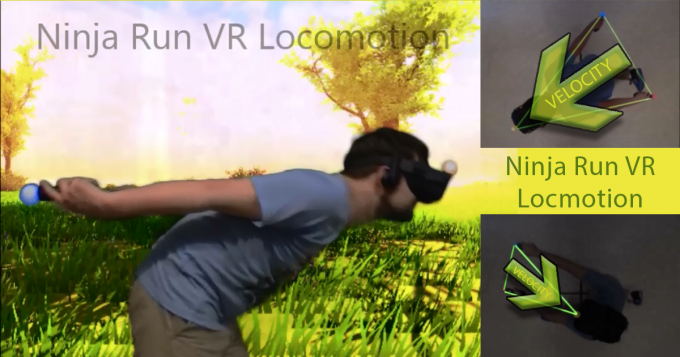This is ‘Ninja Run VR’, and its yet another take on the ever present problem of user locomotion in VR experiences. But, as crazy as the concept looks, there may be some method to its madness.
The question of how best to allow users of VR apps, games and experiences to move around a virtual space is still a hot topic among players and developers. Right now, those titles which require user-controlled movement through a space seem to be settling on some form of VR teleportation – i.e. the point and click approach. But whilst this method is certainly one of the best for avoiding nausea in motion sick prone players, there’s no doubt it lacks the immediacy of linear motion and further more, it can be somewhat laborious to use if you’re wanting to travel large distances.
Now, a developer has come up with a new take on the problem, one that on the surface may well look, well, a little “batshit crazy”. The developer’s name is Sean Hall (whose previous claim to fame is the DIY HoloLens) and his technique is called Shaolinja or ‘Ninja Running’. The technique takes inspiration from a thousand anime and martial arts movies which depict the historical agents of assassination, which often portray the ninja running with arms swept back behind, leaning forward as they go – you can see this demonstrated in the video embedded at the top of this page.
 “In many popular anime and cartoons, characters depicted to be moving very fast are often illustrated with their hands and arms trailing their torso in the direction they are moving,” Hall tells us, “Even though is is unrealistic, it does induce the notion that the person has a super power to move very fast.” Hall’s idea then was to adopt the pose for us in VR. “With my locomotion, the user is allowed the luxury of immersing themselves in a system where they possess that super power. Because moving is tied to muscles and the inner-ear, simulator sickness is profoundly reduced.”
“In many popular anime and cartoons, characters depicted to be moving very fast are often illustrated with their hands and arms trailing their torso in the direction they are moving,” Hall tells us, “Even though is is unrealistic, it does induce the notion that the person has a super power to move very fast.” Hall’s idea then was to adopt the pose for us in VR. “With my locomotion, the user is allowed the luxury of immersing themselves in a system where they possess that super power. Because moving is tied to muscles and the inner-ear, simulator sickness is profoundly reduced.”
The developer has begun to flesh out his concepts too, this has resulted in a demo experience which adopts the technique. He’s released this demo to the public in order to garner more feedback and to gauge whether other developers working on VR experiences would be interested in incorporating it. You can also download the system as a Unity plugin via the asset store here. The project even has its own landing page on Steam, known as ‘Shaolinja’ right here.
So yes, this new locomotion does seem a little ‘out there’ at first glance, but the more I thought about it, the more I reckon Sean may be onto something. Whether he’ll convince other creators to join him in his experiment remains to be seen, let us know in the comments below if you’re considering taking a look.






